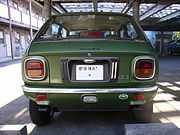Mazda Chantez
| Mazda Chantez | |
|---|---|
 | |
| Overview | |
| Production | July 1972–April 1976 |
| Body and chassis | |
| Body style | 2-door sedan |
| Layout | FR |
| Powertrain | |
| Engine | 359 cc 2-stroke I2 |
The two-door only Chantez (chassis code KMAA), introduced in July 1972, had a longer wheelbase at 2,200 mm (86.6 in) than most of its competitors and boasted the powerful 2-stroke "AA" engine also seen in the Porter. With 35 PS (26 kW), top speed was 115 km/h (71 mph) and the 400-meter sprint was dispatched in a "nippy" 20.6 seconds.[1] In more recent testing of a 1972 GF II, 0–100 km/h came up in 35.8 seconds.[2]

Equipment levels ranged from the lowest spec L (less chrome, body colored bumpers and B-pillars), via the LX, GL, GF, and GL II to the top of the line GF II, which featured a sports interior, radial tires, and available two-tone paint.[3]
1972-1974 Chantez GL II


In late 1974, anticipating a changing law at the turn of the year, the trunklid and front bumper were modified to fit larger-size license plates.
References
- ↑ 1.0 1.1 Rees, Chris (1995). Microcar Mania. Minster Lovell & New Yatt, Oxfordshire, UK: Bookmarque Publishing. p. 80. ISBN 1-870519-18-3.
- ↑ 360cc: Nippon 軽自動車 Memorial 1950→1975 [Nippon Kei Car Memorial 1950-1975]. Tokyo: Yaesu Publishing. 2007. p. 123. ISBN 978-4-86144-083-0.
- ↑ Car Graphic: Car Archives Vol. 5, '70s Japanese Cars. Tokyo: Nigensha. 2007. p. 90. ISBN 978-4-544-09175-5.
| Mazda road car timeline, 1960–1989 — next » | |||||||||||||||||||||||||||||||||||||||||||
|---|---|---|---|---|---|---|---|---|---|---|---|---|---|---|---|---|---|---|---|---|---|---|---|---|---|---|---|---|---|---|---|---|---|---|---|---|---|---|---|---|---|---|---|
| Type | 1960s | 1970s | 1980s | ||||||||||||||||||||||||||||||||||||||||
| 0 | 1 | 2 | 3 | 4 | 5 | 6 | 7 | 8 | 9 | 0 | 1 | 2 | 3 | 4 | 5 | 6 | 7 | 8 | 9 | 0 | 1 | 2 | 3 | 4 | 5 | 6 | 7 | 8 | 9 | ||||||||||||||
| Kei car | R360 Coupé | ||||||||||||||||||||||||||||||||||||||||||
| Carol | Chantez | Carol | |||||||||||||||||||||||||||||||||||||||||
| Kei truck | B360/B600 | Porter | |||||||||||||||||||||||||||||||||||||||||
| Porter Cab | Porter Cab | Scrum | |||||||||||||||||||||||||||||||||||||||||
| Subcompact | Carol 600 | 121/Festiva | |||||||||||||||||||||||||||||||||||||||||
| Compact | Familia | Familia, Presto | Familia Presto | Familia/323 | Familia/323 | Familia/323 | Familia | ||||||||||||||||||||||||||||||||||||
| Familia Van | Familia Van/1000,1200,1300 Pickup | Familia Van/323 Wagon | Familia Van/Wagon | ||||||||||||||||||||||||||||||||||||||||
| Grand Familia / RX-3/Savanna | Étude | ||||||||||||||||||||||||||||||||||||||||||
| Mid-size | Capella/616 / RX-2 | Capella / 626 | Capella / 626 | Capella / 626 | |||||||||||||||||||||||||||||||||||||||
| Luce/1500/1800 | Luce/RX-4 / 929 | Persona | |||||||||||||||||||||||||||||||||||||||||
| Executive | Luce/RX-9 / 929L | Luce / 929 | Luce / 929 | ||||||||||||||||||||||||||||||||||||||||
| Luce Van / 929 Wagon | |||||||||||||||||||||||||||||||||||||||||||
| Luce R130 | Cosmo/121/RX-5 | Cosmo / 929 Coupé | |||||||||||||||||||||||||||||||||||||||||
| Full-size | Roadpacer | ||||||||||||||||||||||||||||||||||||||||||
| Sports car | Familia Rotary/R100 | MX-5 | |||||||||||||||||||||||||||||||||||||||||
| Cosmo Sport | RX-7/Savanna | RX-7/Savanna | |||||||||||||||||||||||||||||||||||||||||
| Minivan | MPV | ||||||||||||||||||||||||||||||||||||||||||
| Pickup | B1500 | Proceed/B-series | Proceed/B-series | Proceed/B-series | |||||||||||||||||||||||||||||||||||||||
| Van | Bongo F800/F1000 | Bongo/E-series | Bongo/E-series | ||||||||||||||||||||||||||||||||||||||||